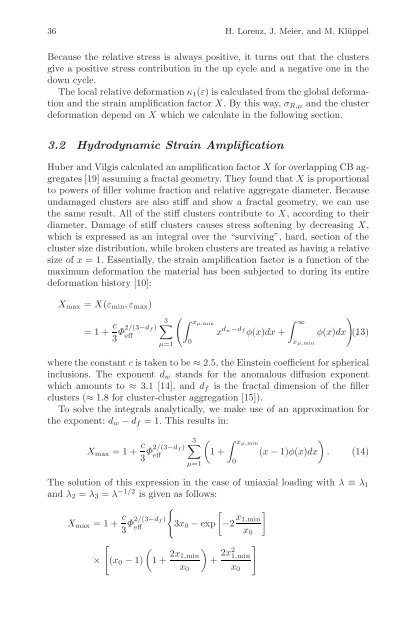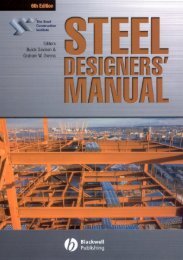Elastomere Friction - The Best Friend international
Elastomere Friction - The Best Friend international
Elastomere Friction - The Best Friend international
Create successful ePaper yourself
Turn your PDF publications into a flip-book with our unique Google optimized e-Paper software.
36 H.Lorenz,J.Meier,andM.Klüppel<br />
Because the relative stress is always positive, it turns out that the clusters<br />
give a positive stress contribution in the up cycle and a negative one in the<br />
down cycle.<br />
<strong>The</strong> local relative deformation κ1(ε) is calculated from the global deformation<br />
and the strain amplification factor X. Bythisway,σR,μ and the cluster<br />
deformation depend on X which we calculate in the following section.<br />
3.2 Hydrodynamic Strain Amplification<br />
Huber and Vilgis calculated an amplification factor X for overlapping CB aggregates<br />
[19] assuming a fractal geometry. <strong>The</strong>y found that X is proportional<br />
to powers of filler volume fraction and relative aggregate diameter. Because<br />
undamaged clusters are also stiff and show a fractal geometry, we can use<br />
the same result. All of the stiff clusters contribute to X, according to their<br />
diameter. Damage of stiff clusters causes stress softening by decreasing X,<br />
which is expressed as an integral over the “surviving”, hard, section of the<br />
cluster size distribution, while broken clusters are treated as having a relative<br />
size of x = 1. Essentially, the strain amplification factor is a function of the<br />
maximum deformation the material has been subjected to during its entire<br />
deformation history [10]:<br />
Xmax = X(εmin,εmax)<br />
=1+ c<br />
3 Φ2/(3−df )<br />
eff<br />
3�<br />
�� xµ,min<br />
μ=1<br />
0<br />
x dw−df<br />
� ∞<br />
φ(x)dx +<br />
xµ,min<br />
�<br />
φ(x)dx (13) ,<br />
where the constant c is taken to be ≈ 2.5, the Einstein coefficient for spherical<br />
inclusions. <strong>The</strong> exponent dw stands for the anomalous diffusion exponent<br />
which amounts to ≈ 3.1 [14], and df is the fractal dimension of the filler<br />
clusters (≈ 1.8 for cluster-cluster aggregation [15]).<br />
To solve the integrals analytically, we make use of an approximation for<br />
the exponent: dw − df = 1. This results in:<br />
Xmax =1+ c<br />
3 Φ2/(3−df )<br />
eff<br />
3�<br />
μ=1<br />
�<br />
1+<br />
� xµ,min<br />
0<br />
�<br />
(x − 1)φ(x)dx . (14)<br />
<strong>The</strong> solution of this expression in the case of uniaxial loading with λ ≡ λ1<br />
and λ2 = λ3 = λ−1/2 is given as follows:<br />
Xmax =1+ c<br />
3 Φ2/(3−df � �<br />
)<br />
eff 3x0 − exp −2 x1,min<br />
�<br />
x0<br />
� �<br />
× (x0 − 1) 1+ 2x1,min<br />
�<br />
+<br />
x0<br />
2x2 �<br />
1,min<br />
x0









